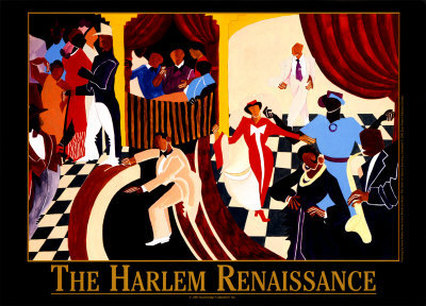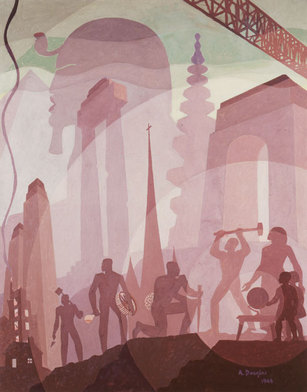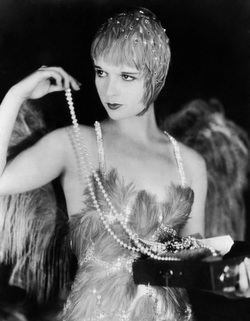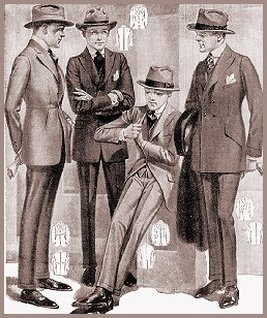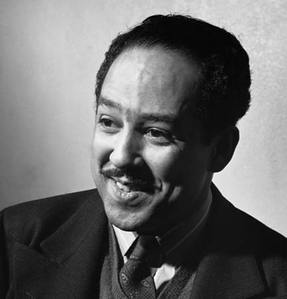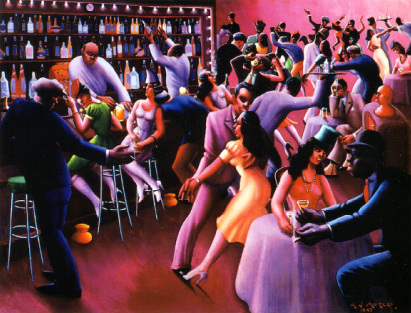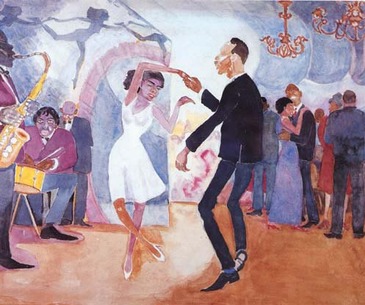The Harlem Renaissance, which spanned the 1920s and 1930s, and was centered in post-World War I America, was more than just a cultural movement. It was an era that brought the African-American race together more than any other previous experience-not since slavery, not since the civil war-had this racial group defined itself in such a unique, colorful way. DS
Visual Artist Spotlight: Edward Kennedy "Duke" Ellington

Duke Ellington at the piano-his source of pride in a period of discrimination and oppression.
Edward Kennedy "Duke" Ellington (29 April 1899-1974) was an American composer, bandleader, and pianist. He was nicknamed "Duke" by a childhood friend and admirer, who thought Ellington's music had the grace of such nobility.
Growing older, he continually stretched and developed the concept of music throughout the Harlem Renaissance and beyond; the word "Duke" became synonymous with a style of music that's dedication and thought behind it was fit to entertain royalty.
As a musician and artist from an early age, Ellington was influenced by famous ragtime pianists like Fats Waller; later, he developed his own styles of jazz techniques and helped expand the horizon of true jazz. DS
DS
Fashion of the Harlem Renaissance
The fashion in the 20’s reflected the Jazz Age, which was influenced by the Harlem Renaissance. Lush style of dressing came about with soft draped materials and salient features. Tea gowns and lingerie dresses were quite prominent. As fashions changed drastically during the early years of this century, wide-ranged styles were socially influenced. In the 1920’s, women were bobbing their hair and they raised their hem-lines. Fringed flapper dresses were the most popular fashion in women’s wear with their feathered headbands.
High fashion until the twenties had been for the richer women of society. Though the construction of the flapper's dress was less complicated than earlier fashions, so women were much more successful at home dressmaking. The flapper fashion style flourished amid the middle class differences between themselves and the truly rich, continuing to highlight some differences with the poor. Embellished silk garments for evening were worn by the rich, though even women of lower social class emerged in the sophistication of very fashionable flapper clothes.
A woman of the 'Roaring Twenties' is actually likely to be the image of a flapper. Flappers did not actually emerge until 1926. Flapper fashion embraced all things and styles modern. A fashionable flapper had short sleek hair, a shorter than average shapeless shift dress, a flat chest, wore make up and applied it in public, smoked with a long cigarette holder, exposed her limbs and displayed the spirit of a reckless rebel who danced all night in the Jazz Age. An iconic flapper woman could be identified as Louise Brooks, who played the lead in numerous flapper films.
In the early part of the 1920's the "conservative suit" was the most popular men’s suit style. Marked by its tightly fitted jacket, high "pinched" waist and narrow shoulders, the conservative suit cut a thin silhouette. Though by 1924, the style of men's suits shifted toward the "Jazz Suit". It was during this time that fine American suit makers, like Brooks Brothers, clothing became the leader in American men’s fashion. Brooks Brothers and other fine men's clothing houses defined the look of the business suit that has been in style for nearly 80 years.
Men wore their hair slicked back with oily, perfumed gel that kept their hair in place, and they parted it in or near the center. Figures like Rudolph Valentino, a film icon, popularized this look on the screen. In the summer, men sported broad brimmed Panama straw hats. For winter wear, felt fedoras were considered casual and acceptable to pair with suits and sport coats. English driving caps were also worn everywhere by men in this era.
NJ
High fashion until the twenties had been for the richer women of society. Though the construction of the flapper's dress was less complicated than earlier fashions, so women were much more successful at home dressmaking. The flapper fashion style flourished amid the middle class differences between themselves and the truly rich, continuing to highlight some differences with the poor. Embellished silk garments for evening were worn by the rich, though even women of lower social class emerged in the sophistication of very fashionable flapper clothes.
A woman of the 'Roaring Twenties' is actually likely to be the image of a flapper. Flappers did not actually emerge until 1926. Flapper fashion embraced all things and styles modern. A fashionable flapper had short sleek hair, a shorter than average shapeless shift dress, a flat chest, wore make up and applied it in public, smoked with a long cigarette holder, exposed her limbs and displayed the spirit of a reckless rebel who danced all night in the Jazz Age. An iconic flapper woman could be identified as Louise Brooks, who played the lead in numerous flapper films.
In the early part of the 1920's the "conservative suit" was the most popular men’s suit style. Marked by its tightly fitted jacket, high "pinched" waist and narrow shoulders, the conservative suit cut a thin silhouette. Though by 1924, the style of men's suits shifted toward the "Jazz Suit". It was during this time that fine American suit makers, like Brooks Brothers, clothing became the leader in American men’s fashion. Brooks Brothers and other fine men's clothing houses defined the look of the business suit that has been in style for nearly 80 years.
Men wore their hair slicked back with oily, perfumed gel that kept their hair in place, and they parted it in or near the center. Figures like Rudolph Valentino, a film icon, popularized this look on the screen. In the summer, men sported broad brimmed Panama straw hats. For winter wear, felt fedoras were considered casual and acceptable to pair with suits and sport coats. English driving caps were also worn everywhere by men in this era.
NJ
Poem of the Day:
The Negro speaks of Rivers
by Langston Hughes
I've known rivers:
I've known rivers ancient as the world and older than the
flow of human blood in human veins.
My soul has grown deep like the rivers.
I bathed in the Euphrates when dawns were young.
I built my hut near the Congo and it lulled me to sleep.
I looked upon the Nile and raised the pyramids above it.
I heard the singing of the Mississippi when Abe Lincoln
went down to New Orleans, and I've seen its muddy
bosom turn all golden in the sunset.
I've known rivers:
Ancient, dusky rivers.
My soul has grown deep like the rivers. SR
Art of the Era
DS
Entertainment in the Harlem Renaissance
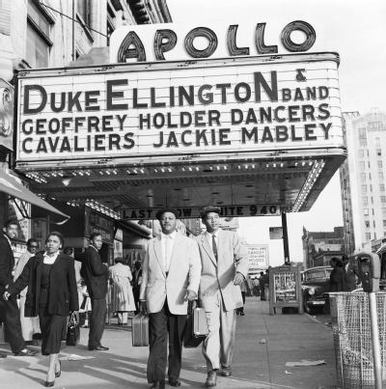
The Harlem Renaissance has always been known to be an era of emergence of art among the African American people; however, the actual integration of various art forms into entertainment for the masses is often overlooked. Entertainment flourished in a variety of forms: jazz and jazz dance; ballrooms and clubs; black musical theater and rent parties.
Music was the foundation for all variations in entertainment, and jazz was the leading style of the day. Its emphasis on improvisation made jazz exciting and unpredictable, drawing large crowds of people and the development of jazz dance. Particularly in the 1930s though, jazz dance was overshadowed by swing dancing, in popular venues such as The Savoy Ballroom and the Cotton Club.
DS
Music was the foundation for all variations in entertainment, and jazz was the leading style of the day. Its emphasis on improvisation made jazz exciting and unpredictable, drawing large crowds of people and the development of jazz dance. Particularly in the 1930s though, jazz dance was overshadowed by swing dancing, in popular venues such as The Savoy Ballroom and the Cotton Club.
DS
Fantastic Solos, Moving Words, and Long-Lasting Memories
In the crowded streets of Harlem, New York City was home to many African American families, in these streets families shook off prejudices and reconstructed confidence in the average African American. Those who dwelled in this lower class neighborhood ended the silent suffering of African Americans and spoke of the previously tabooed subjects in American literature. Through their powerful notes in jazz compositions and released sorrows in their literature, these inspirational writers, actors, and musicians exposed the struggles of middle class African Americans beaten down in American society. In their efforts to tell sing their sorrows away and enlighten the American public of their oppression, they transformed the 1920s into an era of brilliant new musical styles, flashy fabrics, and vivid illustrations that captivated decades of Americans that came to follow.
The voices in Harlem transformed the confidence of millions of African Americans inhabiting everyday homes across the nation. The writers of the Harlem Renaissance, featuring Web Du Bois and Zora Neale Hurston, released the emotions of African Americans though their thought provoking poems and novels; these insights had previously only been spoken by mouth, not written on paper. The foundations within the writers of the Harlem Renaissance is illustrated in the African American Almanac 2009: “Although free expression was essential to artists of the Harlem Renaissance, stereotypes that permeated the American culture made their writings appear rebellious…/…African American artists concerned the definition and celebration of African American art and culture and a desire to change the preconceived and erroneous notions most Americans had of African American life” (African American Almanac 2009). The central message of the Harlem writers circled around the daily difficulties that the average black American encountered; this message enraptured the American public and lifted the self esteem of African Americans. They shed their previous disappointment of their rich dark skin tones; they immersed themselves in the confidence and newly generated pride in being an African American. The days when Blacks were entwined with slavery ended; the era of self worth and self expression began.
Along with the bold new writing styles, the Harlem Renaissance also introduced swing and jazz music. Swing music dominated the night clubs that had increased popularity with the new found prosperity of the Roaring 20s while musicians poured out their souls through bases and trombones. This was the first time where traditional African American music like blues was accepted into American society and not shunned because of there loyalties to previous slave songs. The Harlem Renaissance was the debut of African American pride; its exposure of black struggles intrigued generations that superseded it. Because it revealed the difficulties of the average African American, because marked the end of shame and the start of black self confidence, because it introduced bold writing styles and musical genres, because it gave a voice to the millions of African Americans dwelling within America – the Harlem Renaissance has captivated and influenced others that preceded from the rich traditions of this inspirational movement.
SR
Works Cited
Aaron, Douglas. Building More Stately Mansions. 1944. Fisk University, Fisk University.
Edward Kennedy "Duke" Ellington. Photograph. WTFM. Tumblr, 2010. Web. 20 Jan. 2011.
Garcia, Ercina, Erica Messmer, Caryn Monta, and Kristina Odumes. "Harlem Entertainment." The College of New Jersey Home. n.d.Web. 24 Jan. 2011.
Langston Hughes. Photograph. Amsco Extra! Amsco School Publications, Inc., 4 Feb. 2010. Web. 24 Jan. 2011.
Langston Hughes&Co. Photograph. New York Public Library. The American Novel. Educational Broadcasting Corporation, 2003. Web. 24 Jan. 2011.
Schirmer, G. "Edward K. (Duke) Ellington." G. Schirmer Inc. Apr. 2002. Web. 20 Jan. 2011.
The Apollo Theatre. Photograph. 1957 Time Capsule. Nov. 2010. Web. 20 Jan. 2011.
"The Harlem Renaissance." African American Almanac. Ed. Brigham Narins. 10th ed. Detroit: Gale, 2009. Gale Student Resources In Context. n.d.Web. 20 Jan. 2011.
The Harlem Renaissance. Photograph. Zunal.com. Zunal.com, 2010.n.d. Web. 18 Jan. 2011.
The Harlem Renaissance. Photograph. Zunal.com. Zunal.com, 2010.n.d. Web. 18 Jan. 2011.
"The Negro Speaks of Rivers." Poets.org - Poetry, Poems, Bios & More. n.d.Web. 18 Jan. 2011.
By: Dylan Steiner, Serena Ruffino, and Nia Johnson 2011
